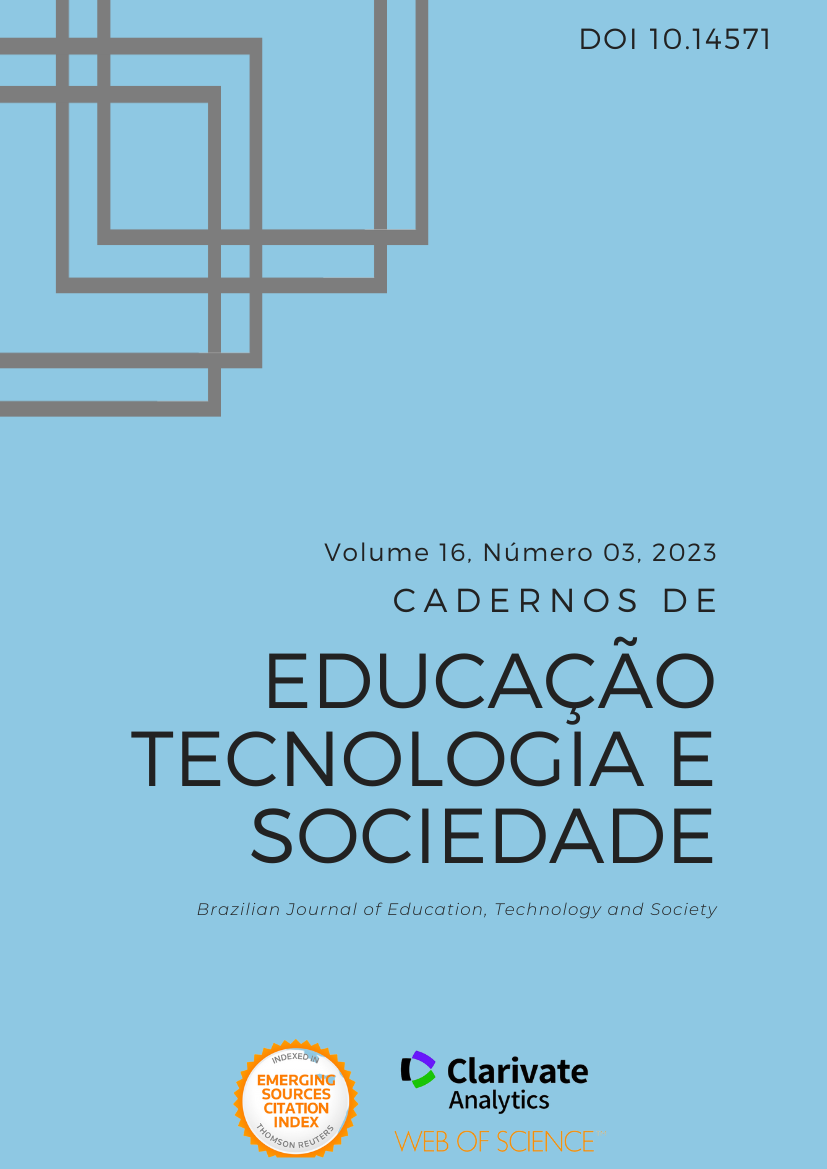O discurso de Cyborg em as Crônicas de Nárnia de Lewis:
uma palestra dromológica-panóptica
DOI:
https://doi.org/10.14571/brajets.v16.n3.697-705Palavras-chave:
tempo, cristianismo, linearidade, velocidade, tecnologiaResumo
Este ensaio tem como objetivo analisar As Crônicas de Nárnia de C. S. Lewis através das teorias da dramatologia de Paul Virilio. C. S. Lewis utilizou a noção relativa de tempo em suas histórias para mostrar que os progressos tecnológicos mudam as crenças clássicas em física para uma física moderna que se baseia nos limites do tempo e do lugar. No marco seguinte, crie discursos fantásticos que se convertem na base do gênero fantástico. No entanto, neste ensaio, o objetivo é mostrar que Lewis atravessou seu próprio tempo, e suas obras manifestaram a progressão da ciência e o surgimento de um novo conceito de tempo diferente da noção clássica. Neste ensaio, o investigador mostra que o tempo é circular, não linear e que os sujeitos podem desafiar o significado tradicional de tempo e lugar.Referências
Aruperes, I., Rorintulus, O. A., & Andries, F. (2023). Kindness In Lewis's The Chronicles Of Narnia: The Lion, The Witch And The Wardrobe. JoTELL: Journal of Teaching English, Linguistics, and Literature, 2(6), 803-817.
Azka, D. R., Wibawa, S. H., & Hadi, S. (2021). The Analysis of King Caspian X’s Struggle to Find His Father’s Seven Best Friends in the Series Novel “The Chronicles of Narnia: The Voyage of The Dawn Treader” By CS Lewis”. Jurnal Penelitian Pendidikan, 13(2), 121-126.
Bartels-Ray, G. (2023). Chronicling Narnia. The Lamp-Post of the Southern California CS Lewis Society, 41(1), 3-27.
Canguilhem, G. (2005). The Death of Man or Exhaustion of Cogito. Gutting, Gary. The Cambridge Companion to Foucault. UK: Cambridge University Press, 89-95.
Colman, F. (2009). Film, Theory and Philosophy, The Key Thinkers. Montreal & Kingston: McGill-Queens University Press.
Daulay, L. A., & Harida, E. S. (2020). Material Processes in Novel the Chronicles of Narnia (the Voyage of the Dawn Treader by c. S. Lewis). In International Online Conference on English and Education (Vol. 1, No. 1, pp. 54-75).
Duncombe, C. (2019). The politics of Twitter: emotions and the power of social media. International Political Sociology, 13(4), 409-429.
Goodlad, M. E. (2003). Beyond the Panopticon: Victorian Britain and the Critical Imagination. PMLA 118: 539-556.
Jamalpour, H., Yaghoobi-Derab, J. (2022). A review of the philosophy of aesthetics and art based on theoretical and methodological considerations. Revista de Investigaciones Universidad del Quindío. Dec 20;34(S2):426-35.
Jamalpour, H., & Derabi, J. Y. (2023). Aesthetic Experience, Neurology and Cultural Memory. Passagens: Revista Internacional De História Política E Cultura Jurídica, 15(2), 340-348. https://doi.org/10.15175/1984-2503-202315208.
James, I. (2007). Paul Virilio. London: Routledge.
Kaplan, D. M. (2004). Readings In The Philosophy Of Technology. Lanham, MD: Rowman and Littlefield.
Lürig, M. D., Donoughe, S., Svensson, E. I., Porto, A., & Tsuboi, M. (2021). Computer vision, machine learning, and the promise of phenomics in ecology and evolutionary biology. Frontiers in Ecology and Evolution, 9, 642774.
Nodar S., Barbosa P., García B., Aguirre C., Gómez, J., (2022), Primary Angiosarcoma of the Spleen with Spontaneous Rupture: A Case Report, Case Report, Clin Oncol Case Rep, 5(9), 5-9.
Putri, K. D. T. A., Utami, I. G. A. L. P., & Mahendrayana, G. (2021). Analyzing Characterization Of Eustace Scrubb In The Chronicles Of Narnia. Lingua Scientia, 28(1), 27-34.
Prati, C. (2021). ROMAN BUNKER ARCHEOLOGY. PAESAGGI URBANI PRIMORDIALI. In GUD Special Edition 2021| Sguardi (pp. 146-151). Stefano Termanini Editore,
Roberts, A. (2006). Science Fiction. 2nd Edition. New York: Routledge.
Siswoyo, S., & Karolina, L. (2022). Analisis Ekranisasi Karaterisasi Peter yang Terdampak Konflik dalam Novel Dan Film the Chronicles of Narnia: Prince Caspian. Sabda: Jurnal Sastra dan Bahasa, 1(1), 72-80.
Suwastini, N. K. A., Widasuari, N. W. D., Wahyuni, L. G. E., & Visestayati, N. P. A. (2020). Lucy Pevensie’s Characterizations In Cs Lewis’narnia: The Lion, The Witch, And The Wardrobe. International Journal of Language and Literature, 4(1), 47-55.
Timmerman, H. (1990). Other Worlds: The Fantasy Genre. Ohio: Bowling Green University Popular Press.
Virilio, P. (2008). Negative Horizon. Trans. Michael Degener. London: Continuum.
Yanti, M. V. (2021). The Analysis of the Characterization of the Pevensies in the Novel of Narnia: The Lion, the Witch, and the Wardrobe. Journal of English Education, Literature and Linguistics, 4(2), 11-18.
Downloads
Publicado
Edição
Seção
Licença
Copyright (c) 2023 Sanay Bayat, Hassan Shahabi, Fatemeh Bornaki

Este trabalho está licenciado sob uma licença Creative Commons Attribution 4.0 International License. A revista segue a política para Periódicos de Acesso Livre, oferecendo acesso livre, imediato e gratuito ao seu conteúdo, seguindo o princípio de que disponibilizar gratuitamente o conhecimento científico ao público proporciona mais democratização internacional do conhecimento. Por isso, não se aplica taxas, sejam elas para submissão, avaliação, publicação, visualização ou downloads dos artigos. Além disso, a revista segue a licença Creative Common (CC BY) permitindo qualquer divulgação do artigo, desde que sejam referenciados o artigo original. Neste sentido, os autores que publicam nesta revista concordam com os seguintes termos: A) Os autores mantém os direitos autorais e concedem à revista o direito de primeira publicação, com o trabalho simultaneamente licenciado sob a Creative Commons Attribution License (CC BY), permitindo o compartilhamento do trabalho com reconhecimento da autoria do trabalho e publicação inicial nesta revista. B) Autores têm autorização para distribuição não-exclusiva da versão do trabalho publicada nesta revista (ex.: publicar em repositório institucional e não institucional, bem como capítulo de livro), com reconhecimento de autoria e publicação inicial nesta revista. C) Autores sãoo estimulados a publicar e distribuir seu trabalho online (ex.: repositórios online ou na sua página pessoal), bem como aumentar o impacto e a citação do trabalho publicado.

